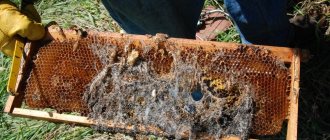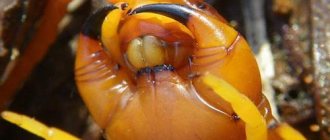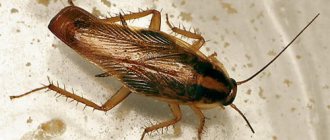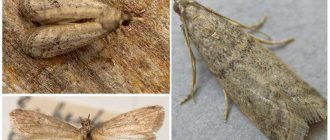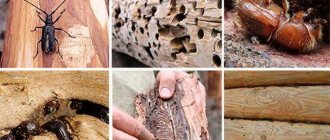The wax moth, or moth, is an inconspicuous butterfly, small in size and modest in color, but has gained fame as a formidable enemy of beekeeping.
The immediate danger to people who breed bees is not the butterflies themselves, but the moth larvae that infect the hives in search of food. Small caterpillars harm beekeepers by eating honeycombs and other products produced by bees.
However, wax moths can provide significant benefits. Based on the caterpillars, medicines are produced that have almost unique medicinal properties.
However, the cultivation of caterpillars is carried out more often in large beekeeping farms; smaller apiaries consider the moths exclusively as parasites, using all available methods and methods to combat them, which we will discuss in more detail later.
Ways to combat wax moths
How to deal with wax moths when a pest appears?
There are a lot of different methods that can be divided into three main groups: biological, chemical, mechanical. The choice of the most suitable one is carried out by determining the degree of infection, the number of honeycombs affected by the moth, and a number of other factors.
It should be noted that bees are quite capable of independently protecting the hive from pest invasion and damage. When the caterpillars penetrate, the insects literally seal the larva, which leads to the death of the latter. It is for this reason that it is extremely important to provide the bees with access to all the nooks and crannies of the hive. However, it is important to remember that bees can only cope with a small number of parasites.
Biological method
So how do you get rid of wax moths in your hive? Beekeepers do not recommend using chemicals to neutralize pests when the number of pests is small. To prevent the appearance of moths, when a small number of pests appear, you can use biological methods, that is, involving the use of products of natural origin.
The leaves of immortelle, mint, and walnut perfectly repel parasites. To eliminate wax moths and prevent their appearance, you need to carefully pour frames prepared for long-term storage.
An excellent remedy for parasites is mint tincture. To kill insects, just mix it with a small amount of water, then pour it between the frames and place it for a day to dry. This product is not harmful to bees. As a rule, the use of these products causes butterflies to settle further away from the treated areas.
Mechanical method
But what to do if moths appear in the hives, but the use of biological and chemical agents is not possible for a number of reasons? In such a situation, it is sufficient to use a mechanical method, which involves shaking the larvae out of the frames manually. In order for the pests to leave the shelter, it is enough to lightly knock on the frame and then shake out the insects.
Available and special chemicals
Before fighting wax moths, it is recommended to carefully study the methods, methods, and means that will help you do this quickly, effectively, and safely for bees. It is best, of course, to use organic means, but with a severe degree of infection, the use of tablets and chemicals may be required.
Salt treatment
The fight against wax moths includes mandatory processing of frames immediately before sending them to the honeycomb storage facility. The easiest way is to use a saturated solution of common salt. After preparing such a product, it is enough to pour the resulting concentrate into a spray bottle, and then carefully treat the potential affected areas. After drying, a white layer forms on the frames, which has a repellent effect on wax moths. This measure will help to effectively protect the dry body from the invasion of moths.
Fumigation
In case of severe damage, you can get rid of parasites on the frames by using ordinary sulfur dioxide. To destroy the parasite, it is necessary to fumigate the frames twice over three weeks at regular intervals; this, of course, should be done before sending the honeycombs to dry. When thinking about how to remove wax moths from a hive, one should not forget about the benefits of these caterpillars. If there are enough parasites, it is quite possible to prepare a useful tincture based on them.
Freezing and heating
As with any other pest, control methods aimed at destroying wax moths include exposure to high or low temperatures. You should know that wax moths die at temperatures below ten degrees.
In order to get rid of parasites, you can take the frames outside in the winter or place them in the refrigerator. To eliminate the possibility of parasite survival, it is recommended to carry out the procedure for at least two hours. Heat treatment involves the use of high temperatures of over fifty degrees.
Vapors of acetic or formic acid
The easiest way to protect honeycombs from wax moths is to treat the frames with formic or acetic acid.
To remove fireflies, simply place a small container with the selected product at the bottom of the box, then cover it on top with a thin layer of polyethylene. It is recommended to periodically check the amount of product, replenishing it if necessary.
Traditional methods
To get rid of wax moths in hives, it is recommended to use various traditional methods. Knowing what parasites are afraid of, you can quickly achieve good results. For example, to prevent females from leaving clutches of eggs, it is recommended to leave several containers on the site, at the bottom of which pour water mixed with sugar and honey. Despite the fact that adult butterflies do not need food, they fly to a pleasant smell.
Ordinary naphthalene will help get rid of parasites. The given substance should be placed directly in the hives using small boxes. To prevent a number of unpleasant consequences, it is recommended to remove these boxes during the main honey collection period.
To remove pests, you can use scented sachet-type pads. To make them, you need to sew gauze into a pillow shape, pre-folded in several layers. Next, you need to place in these improvised pillows any plant that has a distinct specific smell, for example, mint, wormwood, geranium. Place the bags in the room where the dry goods are stored.
To quickly remove parasites, it is recommended to treat hives or honeycomb storage rooms with smoke. In order to obtain it for subsequent fumigation of infected honeycombs, it is necessary to set fire to combustible sulfur.
It is important to use this method with some caution.
It should be noted that if honeycombs are heavily infested, the use of traditional methods may not be effective. To remove large numbers of wax moth larvae, it may be necessary to use strong insecticides.
Ways to combat emerging moth larvae
If a beekeeper notices bee moth larvae, this means that the situation is serious and immediate action must be taken. Control methods will differ depending on whether the pests are found outside or inside the hive.
It is more difficult to destroy caterpillars located in a hive, since the presence of bees greatly limits the arsenal of means used. Getting rid of wax moths is a rather complex process, and several treatments may be required to achieve a 100% result. Several methods are used to control the pest:
- mechanical;
- biological;
- chemical.
Traditional methods have proven themselves well.
Signs of infestation with moth caterpillars
You can determine that there are wax moths in the hive by the following signs:
- bees become lethargic and slow;
- bees often group at the entrance, but are in no hurry to fly out;
- The productivity of bees is significantly reduced;
- More and more dead bees appear, on whose bodies you can see the remains of a web;
- at the bottom of the hive you can see pest excrement, honeycomb particles, cobwebs;
- larvae thrown out by bees from the hive begin to appear near the hive;
- Small gray-beige moths were seen near the hives.
Dead bees
The surest sign is that small light worms have appeared in the hive - wax moth larvae.
How to save a bee family?
Experienced beekeepers know that a strong colony in most cases is able to cope with a bee moth infestation on its own. If the family is not strong enough, then it needs help in fighting wax moths.
If pest larvae are found in the hives, then the first step is to move the family to a new home, on new honeycombs, making sure that the insects have a sufficient amount of food. After this, the frames and hive are thoroughly cleaned, and the honeycombs are treated.
Protecting sushi during storage
One of the most common issues that worries almost every beekeeper is the preservation of land from wax moths. To protect frames during storage, it is recommended to periodically check them for the presence of pests, removing them if necessary. The room where dry goods are stored must be well ventilated.
To repel larvae and adult butterflies, it is recommended to use various plants that have a distinct odor, such as peppermint. The stems should be laid out on the bottom of the boxes, on the floor around the frames. You can use ordinary garlic instead of mint, after cutting several cloves into large pieces.
There are quite effective chemical agents that will also help to quickly repel moths.
Products of this kind are plates that are completely harmless to bees, but destructive to wax moths. Such plates should be placed strictly between the frames. They should be changed as needed.
Prevention
Preventing the appearance of moth larvae is much easier than taking measures to eliminate them. The spread of wax moths is so rapid that in 1 season you can lose the colonies of an entire apiary. How to protect honeycombs from wax moths:
- Regularly inspect the honeycombs for the presence of larvae.
- Take emergency measures to destroy discovered eggs.
- Monitor the hygiene of honeycomb storage and hives.
- Avoid the appearance of cracks, crevices and other defects in the walls of the hives.
- Building hives correctly, maintaining the distance between frames, will allow bees to penetrate even the most inaccessible places and fight the larvae on their own.
- All old cells must be eliminated and replaced in a timely manner.
- If larvae are found in one of the hives, it should be dug into a trench and filled with water, this way you can avoid the spread of pests to neighboring bee houses.
- Store wax raw materials in a tightly closed container.
- Avoid long-term storage of wax.
- Fight wax moths in honeycomb storage.
- Store honeycombs only in cool and ventilated places, avoiding high concentrations of humidity.
- Oregano, mint, geranium, wormwood and hops should be planted in the apiary area. At the moment of flowering, the caps of the plants are torn off and hung inside the hives.
It is difficult to completely get rid of wax moths; it is necessary to combine several methods at once. This is a very labor-intensive process, and yields suffer. The use of chemical methods excludes the use of pumped honey, as it may contain substances harmful to humans.
Signs of bee moth infection
To protect bees and bee products from pest invasion, you need to pay attention to the first signs of wax moths appearing in honeycombs. Factors such as the appearance of thin cobwebs and damage to honeycombs can indicate infection of hives. However, the level of damage may vary depending on the number of parasites.
In the initial stages of formation, pests eat exclusively bee bread and honey. Subsequently, the diet of insects expands significantly; wax, insulation, and other products produced by bees are used. As the larvae grow, they diligently make passages in the walls of the honeycombs, thereby rendering them unusable.
Catching moth butterflies
To prevent butterflies from getting into hives or frame storage and laying eggs, it is easier to catch them. To do this, use liter jars filled with 3-4 cm of bread kvass, which are placed on the hives and in places where honeycombs and small frames are stored. The smell of bread kvass attracts butterflies. They fall onto its surface, their wings get wet and they can no longer get out of the jar. In addition to butterflies, no less harmful and annoying flies and midges get into jars.
During honey harvest, bees do not react to kvass and do not get into the jars. During the bee-free period, the jars are covered with plastic lids while the bees are flying. During the first day, from 30 to 70 butterflies end up in each jar. Subsequently, their number decreases. Catching butterflies with little time spent significantly reduces damage from wax moths.
Yu.I.Hupaviy
Causes of hive damage
There are several main reasons for the appearance of pests in storage facilities and hives. Especially often, parasites infect old hives that have a large number of cracks and gaps in which female wax moths can lay eggs without hindrance. Insects are also attracted by the lack of necessary cleanliness. The presence of wax or other bee products at the bottom of the hive can be considered by wax moth larvae as an invitation card.
The larvae can move quite freely between hives. It is this ability that simply explains such a high level of prevalence of parasites. The absence of protective grooves between bee houses and plants that insects are afraid of leads to the rapid spread of wax moths.
Causes of bee moth infestation
There are no specific reasons for wax moth infestation of hives. From the peculiarities of its life activity, it is known that it lives mainly in steppes and forests, where apiaries are concentrated. Botanists explain this fact by the fact that the honeycombs contain useful and nutritious substances necessary for the growth and development of larvae. If we consider an adult, it lacks a digestive tract and therefore does not need nutrition. Its life cycle involves 2 weeks, during which time it is fed only by accumulated substances obtained during the ripening period. At the moment when she was a larva.
The bee moth is very prolific, capable of laying up to 300 eggs at a time, and this is only in one clutch. Over its lifetime it can lay up to 1,500 larvae. This explains its wide prevalence, since one individual can affect an entire apiary, or even all nearby beekeeping farms.
An adult sneaks into the hive at dusk and lays eggs in gaps, crevices, on a tray, near honeycombs and in other hard-to-reach places. It is almost impossible to notice them right away. After 10 days, numerous larvae hatch from them, their size is no more than 1 mm. If you look closely, you can see a yellowish head. Due to the presence of a nutrient medium in the form of honeycombs and woody components of the hive, they quickly gain mass and reach a length of up to 3.5 cm. By the end of the month, she forms a cocoon, which she hangs in the cracks and corners of the bee house. After another 10 days, a new individual wax moth appears, ready to again lay numerous offspring.
Among the main reasons are:
- low activity of bees, which are unable to free the hive from pests;
- excessive humidity due to the climatic characteristics of the region in which the apiary is located;
- increased accumulation of beebread;
- death of the uterus;
- contaminated honeycombs;
- non-compliance with temperature conditions during wintering;
- increased accumulation of dead bees inside the hive;
- insufficient hygiene.
Preventive measures
In order to protect the results of beekeeping in the apiary, to save the frames from the invasion of wax moths, it is imperative to take preventive measures. For example, to prevent the spread of parasites, it is enough to dig small grooves between the hives, filling them with water if necessary. This measure will help prevent the larvae from crawling from one hive to another.
It is especially important to inspect your honeycombs regularly.
If any damage appears, it is advisable to completely remove it. It should be remembered that bees can easily cope with parasites on their own. But to do this, they must be provided with access to the most secluded corners of the hives. When butterflies enter there, the guards literally push out the pests, thereby preventing the female from laying eggs.
For beauty, benefit, and repelling insects, it is recommended to plant as many plants as possible around the apiary, the aromas of which moths cannot tolerate. These plants include geranium, lavender, mint, and wormwood. This measure will help to significantly reduce the likelihood of beekeeping being infected by wax moth larvae.
Fumigation with smoke
In the autumn-winter-spring period, when the nests of bee colonies need to be reduced, excess honeycombs have to be taken from the hives and stored separately in the hives or in special rooms. This is where the wax moth begins its harmful work. I smoked the honeycomb with sulfur. Moths did not breed in them, but the bees were reluctant to accept them. I left it in the hives behind the diaphragm for the winter - the honeycombs became moldy from the humidity. I put freshly picked lemon balm in the hives with honeycombs, sprinkled the honeycombs with dry mint, but the moths still started. I treated the honeycombs with vinegar - the moth died and did not start again. But this method has its own drawback, which cannot be ignored - acetic acid causes the wire in the honeycomb to rust and break. An old beekeeper once told me that in order to keep the honeycombs free from moths, he smoked them with ordinary smoke from a beekeeper's smoker. I immediately took advantage of his experience. In a container lined with tin so that mice would not penetrate into it, he hung several tiers of honeycombs at a distance of 12 mm from each other, like in a beehive, closed it tightly and filled it with smoke through a special hole at the bottom. I keep the chimney burning throughout the day. I repeat this fumigation three times at weekly intervals: in autumn and spring. If moths have already started in the honeycombs, then their caterpillars become inactive from the smoke, stop feeding, and die on the second or third day. The smell of smoke from the honeycombs subsequently disappears, and the bees readily perceive them. It is also interesting that moths no longer lay eggs in smoky honeycombs.
V. Nedbeev
Oh moth
This tiny insect is capable of destroying about 2 g of wax in a month.
A completely unnoticeable amount, right? But no! Two grams of wax is about 600 processed honeycomb cells. When calculating damage, it is important to remember that there is more than one parasitic insect in the hive. One clutch can contain about 300 eggs. In 14 days of life, the female is capable of making about 5 clutches. Having made some simple calculations, it is clear why there is an urgent need to get rid of such a pest. An adult insect does not cause direct damage to bees, since it does not even have a mouthpart. She lives off previously accumulated reserves. Its main function and harm is laying eggs in the cracks of hives.
Important!
The moth loves dry heat and is most often found in regions located high above sea level.
Wax moth
The fight against wax moth should begin with studying information about it. Thus, two types of insects lay larvae in the hive: small and large. Their eggs can be found in litter at the bottom of the hive, in cracks in walls, in cells and in raw materials for wax. Three generations of moths can change in one season. The insect spends the winter in the pupal stage.
Over time, moth caterpillars emerge from the eggs. They make moves through the honeycomb in different directions, enveloping their path in a web. The web clogs the honeycomb, preventing the bees from storing the honey. These actions destroy the cells of the cell. Gradually, the honeycomb is destroyed, filling with cobwebs and caterpillar feces. The parasite's secretions pollute the air, forcing bees to leave their hive.
Interesting!
Strong, well-developed families are able to fight individual pests on their own. The worker bees simply tear the discovered “guest” into pieces. However, not every bee colony has the potential for this level of development.
